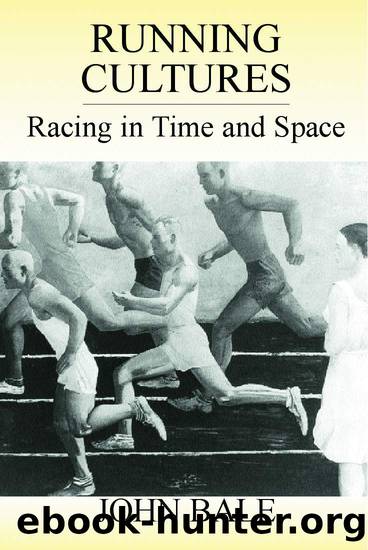Running Cultures by Bale John;

Author:Bale, John;
Language: eng
Format: epub
Publisher: Taylor & Francis Group
Transgression
It has long been believed in Europe that Africa is a storehouse of fantastic athletes. Disappointed by their nationâs perceived mediocrity in the 1936
Olympics, French journalists suggested that their coaches should venture into the colonial bush and bring home African athletes to compete for the mother country.30 The British colonial system was different and sport tended to be taken to the African rather than vice versa. A large number of change agents were involved in setting up sport in Africa. These included missionaries, schoolteachers, local administrators, plantation owners and military and police physical education instructors. They did not find it necessary to disguise their motive â that of social control.31
In the early 1950s the prevailing western view was that African track athletes, like African Americans, possessed âgreat speed but little staminaâ.32
Middle-distance running (that is, track racing beyond 800 metres) was read as being the preserve of the âwhiteâ athlete, epitomized mainly by Nordic runners such as Paavo Nurmi in the 1920s, Taisto Mäki in the 1930s, and Gunder Hägg in the 1940s. During the 1950s it was the Czech Emil Zátopek who was the nonpareil of distance running. To be sure, in the 1948 Olympics Alain Mimoun from Algeria, who ran in the colours of France, gained second place in the 10,000 metres. He went on to win two silver medals, in the 5,000 and 10,000 metres at the 1952 Games, and capped his career by winning the1956 Olympic marathon. In 1952 he was the only African in the top 60
5,000-metre runners in the world.33 But by representing France Mimoun could immediately be read as an ambiguous African hero. Indeed, he could be argued to have represented France in more ways than one. He assumed âFrench-nessâ by dropping the Algerian element in his surname (Oâkatcha) and supported France in the war against Algeria. He was the colonized athlete and did not represent âblacknessâ in the way that athletes from central and southern Africa might. It was the âArab northâ rather than âBlack Africaâ that Mimoun represented â if he represented Africa at all. Not until the Rome Olympics in 1960 was the black athlete with stamina made visible to a global audience, when the Ethiopian athlete Abebe Bikila claimed victory in the marathon.
In contrast to Mimoun, consider the example of Nyandika Maiyoro, born in 1930 in the Kisii district of Nyanza province in the Rift Valley of western Kenya. As a young man he took part in district and provincial track meetings before becoming a national champion and record holder. Maiyoro seems to have made his first international appearance, at least outside of British East Africa, in a meet in Madagascar in 1953. He was entered for the 3,000 metres race and emerged a local hero. Apparently, he failed to arrive at the start in time and only started when the rest of the field was 100 metres down the track. He closed the gap after 4 laps and proceeded to win the race by50 metres. The following year a team of Kenyan athletes took part in the Empire Games in Vancouver.
Download
This site does not store any files on its server. We only index and link to content provided by other sites. Please contact the content providers to delete copyright contents if any and email us, we'll remove relevant links or contents immediately.
| Africa | Americas |
| Arctic & Antarctica | Asia |
| Australia & Oceania | Europe |
| Middle East | Russia |
| United States | World |
| Ancient Civilizations | Military |
| Historical Study & Educational Resources |
Cat's cradle by Kurt Vonnegut(14760)
Pimp by Iceberg Slim(13779)
Underground: A Human History of the Worlds Beneath Our Feet by Will Hunt(11839)
4 3 2 1: A Novel by Paul Auster(11791)
The Radium Girls by Kate Moore(11621)
Wiseguy by Nicholas Pileggi(5318)
American History Stories, Volume III (Yesterday's Classics) by Pratt Mara L(5136)
Perfect Rhythm by Jae(5072)
The Fire Next Time by James Baldwin(5017)
Paper Towns by Green John(4799)
Pale Blue Dot by Carl Sagan(4618)
A Higher Loyalty: Truth, Lies, and Leadership by James Comey(4551)
The Mayflower and the Pilgrims' New World by Nathaniel Philbrick(4281)
The Doomsday Machine by Daniel Ellsberg(4246)
Killers of the Flower Moon: The Osage Murders and the Birth of the FBI by David Grann(4189)
Too Much and Not the Mood by Durga Chew-Bose(4095)
The Sympathizer by Viet Thanh Nguyen(4095)
The Borden Murders by Sarah Miller(4019)
Sticky Fingers by Joe Hagan(3912)
